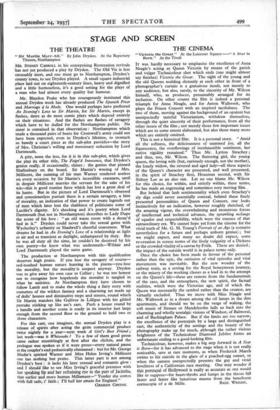THE CINEMA
" Victoria the Great." At the Leicester Square—" A Star is Born." At the Tivoli
IT was hardly necessary to emphasise the excellence of Anna Neagle's acting as Queen Victoria by means of the garish
and vulgar Technicolour shot which ends (one might almost
say finishes) Victoria the Great. The sight of the young and the old Queens nodding distantly at each other in front of a
photographer's curtain is a gratuitous insult, not merely to any audience, but also, surely, to the sincerity of Mr. Wilcox himself, who, as producer, presumably arranged for its inclusion. On other counts the film is indeed a personal triumph for Anna Neagle, and for Anton Walbrook, who plays the Prince Consort with an inspired tactfulness. The two of them, moving against the background of an opulent but unexpectedly tasteful Victorianism, withdraw themselves, through the quiet sincerity of their performance, from all the other issues of the film ; not merely those few important issues which are to some extent elaborated, but also those many more which are entirely omitted.
This is not a historical film. It is a personal story. " Amid all the softness, the deliciousness of unmixed joy, all the liquescence, the overflowings of inexhaustible sentiment, her native rigidity remained." Thus Mr. Lytton Strachey ; and thus, too, Mr. Wilcox. The fluttering girl, the young queen, the loving wife (but, curiously enough, not the mother), the lonely widow, the revered and aged lady—all these aspects of the Queen's character are presented, and well presented, in the spirit of Strachey first, Housman second, with Sir Sidney Lee as an also ran. Let no one blame Mr. Wilcox for this choice, for within, and strictly within, these terms, he has made an engrossing and sometimes very moving film.
But behind that lush sentimentality which even Strachey's sly digs could never essentially conceal, behind these finely presented personalities of Queen and Consort, one looks instinctively for an indication, however roughly sketched, of the amazing vigour, the overwhelming and monstrous forces of intellectual and technical advance, the sprawling mélange of squalor and respectability, which were the essence of that extraordinary era. We cannot hope yet from the cinema for the vivid truth of Mr. G. M. Young's Portrait of an Age (a scenario nevertheless for a future and perhaps unborn genius) ; but we might expect, and many no doubt did expect, some re-creation in screen terms of the lively vulgarity of a Dickens or the crowded vitality of a canvas by Frith. These are denied ; the impact of the outside world is in palace terms only.
Once the choice has been made in favour of the personal rather than the epic, the omission of vital episodes and vital movements was inevitable. But the new wonder of the railway train, as a setting for the Royal honeymoon journey, or the misery of the working classes as a lead in to the attempt on the Queen's life—these are remote from the fundamentals of the case, and the atmosphere, the new spirit, the factual realities, which were the Victorian age, and of which the Queen was necessarily the symbol rather than the creator, are virtually excluded. Thus we move with Miss Neagle and Mr. Walbrook as in a dream among the oil lamps in the dim apartments, and should we be on the verge of waking, the soft music of Strauss or Mendelssohn lulls us back into the charming and wholly nostalgic visions of Windsor, of Balmoral, and of Buckingham Palace. But if the limits are too narrow, the excellence of the portrayals by a large and distinguished cast, the authenticity of the settings and the beauty of the photography make up for much, although the rather vicious brightness of the Technicolour Diamond Jubilee forms an unfortunate ending to a good-looking film.
Technicolour, however, makes a big step forward in A Star is Born—for it has advanced to the stage when it is not really noticeable, save at rare moments, as when Frederick March swims to his suicide in the glare of a poached-egg sunset, or when the camera unexpectedly presents the gay and vivid loveliness of a Californian race meeting. One may wonder if this portrayal of Hollywood is really as accurate as one would like to suppose—for heart-throbs and lumps in the throat fall faster and faster like luxurious manna from the beneficent


















































 Previous page
Previous page